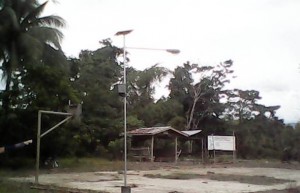
In the remote village of Barangay Sto. Niño in Upper Nanaga, Talaingod, Davao del Norte, residents are already home right after the sun has set. By 6 pm, the whole village is pitch black with nary a sound.
According to villager Antonio Villanueva, this is not unusual especially for Barangay Sto. Nino, which is a conflict-affected area. In this village, theft is common and the “pangayaw,” a traditional tribal war of vengeance, is a daily fare. Roughly 70 percent of the residents of Talaingod belong to the Manobo tribe.
Today, Barangay Sto. Nino is a picture of a happy village. Even after the sun has set, children are still out on the streets playing. Mothers are still busy with their daily household chores, while the fathers gather in one corner for a light banter after a day’s work. By 6 pm, the whole village is still bright and lively with four units of solar-led streetlights and 24 units of solar home lightings put up through the Kapit-Bisig Laban sa Kahirapan-Comprehensive and Integrated Delivery of Social Services-Payapa at Masaganang Pamayanan or the KALAHI-CIDSS PAMANA.
Villanueva, who is also a KALAHI-CIDSS PAMANA community project management committee (CSPMC) chair, said that the P360,075 lighting project will allay the fears of residents since it will deter crimes. “Tungod sa kangitngit, daghan ang kawat. Dili pud namo makita kung kinsa ang mangagi tunga sa kagabhion (Burglary and theft are usually committed as it used to be very dark at night. Also, we could not see those people who pass by our village in the middle of the night),” he explained.
“Kining among napili nga project gumikan kay kana among lugar diha sa Upper Nanaga, hilit gani (We chose this project because our place in Upper Nanaga is very remote),” Villanueva added, pointing out that just recently there was even a “pangayaw.” “Pangayaw is a big problem for the people in the community.”
“Kasagaran sa mga trahedya sa mga lumad, kining pangayaw. Kung naa’y makasala sa ilang paryente, mopataka lang og patay. Tanan makit-an patyon (The usual tragedy for the lumads happens during pangayaw. The aggrieved party will not stop seeking revenge until they kill somebody. Anyone who crosses their path will also be killed),” Roger Son, KALAHI-CIDSS PAMANA Bids and Awards Committee chair, explained.
“Karon nga naa na’y solar, mawala gyud ang kagubot kay maalanganin na sila moduol kay hayag na man (Now that we have solar panels, we can prevent crimes from happening. People with ill intentions will be hesitant to go near us since our surroundings are now well-lighted. Our community will now be peaceful),” Villanueva added.
Conflict-sensitive
PAMANA is the national government’s framework and program for peace and development in conflict affected areas. It is implemented by various government agencies with the Office of the Presidential Adviser on the Peace Process (OPAAP) as lead agency.
For its part, the DSWD implements PAMANA using the KALAHI-CIDSS modality. KALAHI-CIDSS is a community-driven development project that aims to empower communities through their enhanced participation in local governance and poverty alleviation. Under KALAHI-CIDSS, beneficiaries decide on projects that they need most.
The KALAHI-CIDSS PAMANA aims to improve access of conflict affected and vulnerable areas to basic social services and accountable governance in identified PAMANA zones utilizing the community-driven development (CDD) strategy. It has an open menu system of interventions and activities, so communities themselves can choose what conflict-sensitive and peace-promoting projects to implement. Implemented under KALAHI-CIDSS PAMANA are livelihood projects, healing sessions for those who need counseling after exposure to conflict, and social service facilities like day care centers, health stations, among others.
The DSWD started to implement KALAHI-CIDSS PAMANA in 2011 in 149 barangays in Regions IV-A, V, VIII, IX,X,XI, XII, and CARAGA with a budget of P51.7 million. In 2012, it covered 708 barangays with a budget of P268 million. For 2013, a total of 1,391 barangays are covered with a budget of P483.5 million.
Under KALAHI-CIDSS PAMANA, each conflict affected barangay is given P300,000.00 for its chosen peace development project.
Social Welfare and Development Secretary Corazon Juliano-Soliman said that “engaging people to decide on how to restore order in their own communities is the best way to achieve lasting peace. This is why we used the KALAHI-CIDSS process, so that the beneficiaries themselves are instrumental in their own development.” ###


